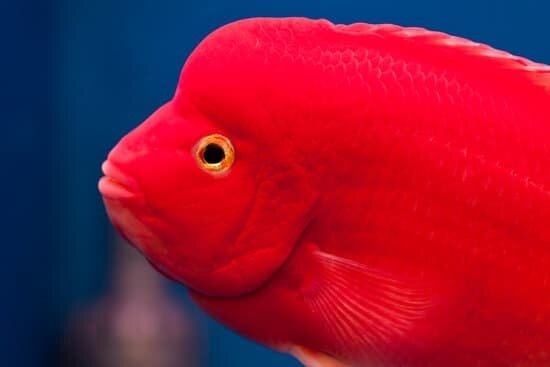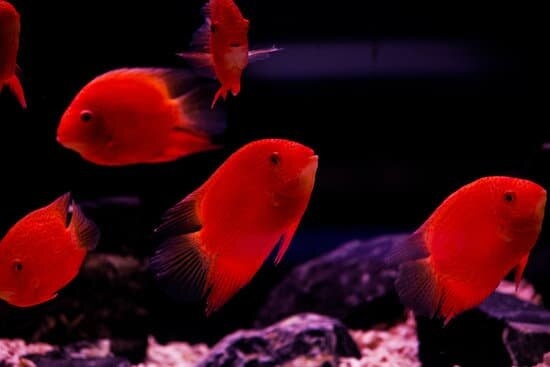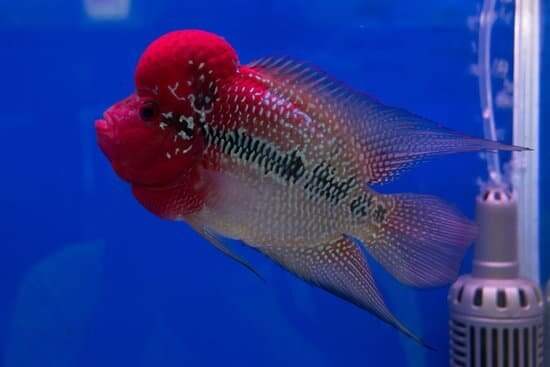Scientifically, they are called Harlequin cichlids and True Red Terror cichlids. They are also called Red Terror cichlids, and Cichlidae is their family. They come in a wide range of colors and patterns.
Red Terrors aren’t just scary because of their bright red color. They also have very aggressive and loud personalities.
You can find these fish in tributaries and rivers all over West and South America. They can be located as far south as the Rio Esmeraldas River in Ecuador and as far north as the Ro Tumbes basin in Peru. The True Red has also been seen in Singapore, where it is seen as an invasive species.
If there is a lot of movement in the water, these fish like to hide in holes and dents under snags where tree branches hang over the water’s surface.
Table of Contents
Red Terror Cichlid Care
Red terror cichlids can be extremely violent and aggressive and can kill or harm their tankmates, which is why caring for this fish can be tricky. They need to be kept in specific aquariums with enough space and tankmates that they can get along with and coexist with amicably to keep themselves healthy.
What Are Red Terror Cichlids?
Many people know that this kind of fish is dangerous and violent, and its name implies that it will attack and eat its tankmates for lunch, which makes sense.

Even though they have a terrible reputation, red terror cichlids are trendy aquarium pets because they add color and vibrancy to any tank.
Indeed, this species could be a great addition to your family’s living space. More than that, these fish have a unique personality and a long history that goes back millions of years, which makes them very interesting.
They are large fish with broad bodies that are easy to notice from above because of their large size. They are vibrant red and orange hues, with vertical black stripes running down her back.
The male red terror cichlids are bright green with red and orange markings and black lines that make them look different.
There are many shades of red terror cichlids, and only when they are older do, they take on the appearance of red fire.
Red Terror Cichlids Appearance
They can be red, orange, or green. These fish have black stripes that run down the length of their bodies. When the red terror cichlid looks at the sky, the top of its dorsum and anal fins are black.
On the female, True Red is a reddish-brown color with vertical black stripes and tiny blue spots that make her look beautiful. This is how her snout looks: It’s a bright red orange. Males have a turquoise-green body and a tail with orange and blue stripes.
They have vertical black stripes and tiny blue dots on their bodies when they’re full grown. Besides that, they have a reddish-orange color that makes them easy to see in the aquarium.
Females in breeding conditions are frequently brighter in color than males. The male Red Terror cichlid is substantially more significant than the female, and as they mature, their colors fade. By the time the male is three years old, he has gained a pronounced nuchal hump on his forehead.
Difficulties In Keeping Red Terror Cichlid
They are a type of animal that can be aggressive or very aggressive. As the name implies, this fish is said to be bold and violent. As the name suggests, it is said to attack and eat its tankmates for lunch. For this reason, the fish is often kept in specific aquariums. Caring for this fish can be a little tricky.
Keeping a breeding pair of True Red Terrors in the same tank as any other fish species is not recommended. Suppose a couple of breeding fish is present in the aquarium. It’s a fact that they will be hyper-aggressive against their tankmates, and they will either kill or intimidate them into a tiny area inside it, regardless of the aquarium’s size.
How Many Red Terror Cichlid in Same Tank?
In a tank, maintain just one adult fish species or a well-formed fish pair (male and female). It is also critical for aggressive fish species like the Red Terror to provide them with appropriate aquarium space and tank mates with whom they can co-exist peacefully to maintain their well-being.
It might be possible to keep the fish in a big tank with other big fish and fight a lot of the same kind. They are all excellent options for aquariums. Flowerhorn, Oscar fish, green terror, and jaguar cichlid are good choices. The sailfin pleco, the common pleco, and the Arowana are all species that are different from each other.
To figure out how a company like this will do before it even starts, you have to know how the workers will act. Aquarists and their pets live peaceful lives, but sometimes the fish die or get hurt because of the work these people do.
Care Guide for Red Terror Cichlids
When dealing with big and aggressive fish, it’s essential to give them enough space to live in. This makes them less aggressive and ensures that the fish grows healthy.

Because these fish are found in shallow and murky waters in nature, they don’t care what kind of light they get. You can even add rocks and caves to your design to make dark hiding places. But floating plants are a great way to create shade and look like a dark natural world.
Behavior And Compatibility
The red terror cichlid is one of the most aggressive cichlids, and if given a chance, it will attack and even eat smaller fish. If something threatened their home, red terror cichlids would fight to the death to keep it safe. They will need to make sure there is enough space in their tanks for a red terror to swim around.
You can do this if you want to keep a red terror in the same tank as other fish that aren’t afraid of humans. Red terror cichlids sometimes use jaws to fight each other.
Knowing that red terror cichlids are violent because they are very territorial in their native environment can help you learn more about how they act and what they like to do. The group’s name shows how they think about the world around them.
As a group, the female terrors become more aggressive during mating season. At their most dangerous, they are at their peak during this time. If females can kill their male partners without drawing attention to themselves, they will.
Because they are very aggressive, you should not keep them calm or small fish. If you do, they will feed on them and be very bad.
Fish that don’t get along may die if they stay together long. The Red Terror may be brutal to make because of problems with pairing. The best way to get a real pair is to raise six juveniles until a strong couple emerges. Furthermore, it might be hard to find an aquarium and breeding surfaces big enough for it because it is so big.
- Sexual Dimorphism
Gray and black stripes down the backs of young men and women make them look like they’re gray and black. Sexual dimorphism is becoming more visible as they grow and mature.
The female will have a yellowish-orange color under her black stripes as she gets older.
Fins turn bright red or orange during this time, and they have a lot of bright turquoise spots on their bodies. It doesn’t make sense to buy a male or a female until they are adults because they look almost the same.
- Reproduction
It’s essential to keep in mind that fish form groups as they get older, which should be kept in mind. Future couples choose each other on their own and only their know-how. After that, they can keep the connection going for a long time.
The chances of having a relationship just by putting a man and a woman together are almost non-existent. When you do this, you will only get one fish dead, and one fish will keep attacking the other fish until you stop them.
When the Red Terror cichlid reaches three to four inches in length and starts to display color changes, it is considered sexually mature and ready to reproduce. Female specimens preserve the appearance of the juvenile Red Terror.
A similar process occurs in which males begin to shed the dark bars on their bodies and acquire a bright, shimmering green body with a characteristic red blush on their belly and neck parts.
It is expected that she will lay anything between ten and one hundred eggs throughout her lifespan, each of which will hatch in around four days.
The parents create slight depressions in the substrate to accommodate the fry until they are big enough to live independently when they reach maturity. Parental fish will fiercely guard their offspring during this stage, which will last until the juveniles reach adulthood.
Red Terror Cichlid – Feeding
Most of the high-quality cichlid pellets on the market can be used by fish keepers to feed their Red Terrors as their primary food source.
You can add live or frozen ghost shrimp, mealworms, earthworms, Daphnia, bloodworms, and other things to your fish’s food to make it more interesting.
People who live in the Red Terror’s home environment eat small crustaceans, fish, and insects. They find them on the banks and tributaries of the rivers and lakes where they live. A fish fry is also a tasty addition to the Red’s menu.
The best way to feed fish in a tank is to use high-quality food for giant cichlid species as the primary source of nutrition, with live or frozen food added as needed to make up for this.
According to scientific evidence, the species eats benthic aquatic crustaceans and other invertebrates as its primary food source. Is likely to eat other fish’s eggs and a wide range of fruits and nuts, too.
Omnivorous. It’s best to feed your fish an excellent, high-quality, meaty, cichlid pellet as their primary food. Most foods are acceptable, and dry food made just for big carnivorous cichlids is the best choice.
Earthworms and mealworms are good choices for great live and frozen foods that need to be fed often.
Red Terror Cichlid – Natural Habitat
There are a lot of Red Terrors in Central American rivers and their tributaries, and they can also be found in Peru and Ecuador.
Red terror cichlids are native to South America’s Rio Esmeraldas River, and they may be found across the western half of the continent. These fish, which may grow between 13 and 18 inches in length, are very territorial and aggressive in their behavior.
Minimum Tank Size for Red Terror Cichlid
Because red terrors may grow to tremendous sizes, a tank capacity of 180 gallons for one fish is recommended. If you wish to bring in a pair of fish or introduce tankmates, make sure the aquarium is at least 84 inches long.
This approach seems to be as if someone is continually digging up the bottom substrate and removing tank plants from the tank. Because of their tiny size, small pebbles or granite chippings will be the most effective substrates for tank bottom substrates.
The stones on the tank’s bottom are critical because they will help partition its bottom area into many sections.
In addition, you can use large stones to construct caves and rock shelters, which are significant hiding areas for cichlids that like to be alone for a lengthy amount of time in their aquarium.
Several stones with a flat surface should be used as a flotation device in different spots around the tank’s bottom. They are necessary if the fish population in a community tank starts to reproduce and lay eggs, which is likely to occur.
Using plants to house your tank plants is recommended, then digging them into the bottom substrate and decorating them with flowers or other decorations.
Tank plants must be hardy, fast-growing, and have strong roots to live in the tank environment. Tank layouts with thick plantings also provide excellent hiding places for the fish.
Water Parameters for Red Terror Cichlid
People who live in the real world might see these freshwater fish swimming in waters that can be both dangerous and warm. Fish keepers need to make sure that the water parameters in their aquariums match those in the fish’s home tropics.

Female red terror cichlids will need a smooth surface, like rocks or slate, to lay their eggs to reproduce, so they will need to find one. It could also be used on its own as a mix of sand, pebbles, and gravel as the foundation.
We should keep the water temperature between 77 and 82°F, but it should not be too hot or cold. People should keep their pH levels between 6.0 and 8.0, and they also need the KH level to be between 2 and 10.
If you want to enhance spawning in the breeding tank, you may gradually raise the water temperature in the breeding tank to 82°F, drop the hardness of the water to 10, and change the pH level to 7.0 over time.
Because these fish are susceptible to changes in the water, it is essential to check the water quality often. Your local fish shop will have a lot of things that will work well for this project, which is a good thing to do.
When keeping big cichlid species in aquariums, people will require powerful mechanical and biological filters to keep the water clean enough for them to live in. However effective your system is, you will still need to replace the water every month to prevent nitrates and other contaminants from accumulating in the water.
As a side note, if you plan on adding plants to the aquarium bed, make sure they are firmly attached. Red terrors are diggers who enjoy removing plants from their homes.
Red Terror Cichlid – Tankmates
The Red Terror cichlid is a fearsome creature, as previously said. If you do decide to establish a community tank, it is advisable to add other big and aggressive fish in the mix, such as the following:
● Arowana
● Sailfin pleco
● Oscars
Boulders and chunks of slate used to build artificial caves are suitable materials for this. People should not play around with the fish Cichlasoma festae because it is hazardous and should not be played with. If it’s big and angry, it could cause many problems in an aquarium because it’s so aggressive.
Breeding Red Terror Cichlid
Approximately three to four inches in length is when male red terror cichlids lose their vibrant colors. This is a sign that the guys are of reproductive age and are ready to have a family.
Because these fish are selective in their mates, they often stay with the same mate for the duration of their life. Putting two red terror cichlids together will result in them fighting with each other, resulting in their deaths.
Whenever possible, it is ideal for letting a pair of red terrors establish themselves naturally in a juvenile community tank before attempting to mate with one another. When it comes to selecting a mate for themselves, female red terrors are more aggressive than male red terrors in their approach. To determine whether or not a male red terror is strong enough for mating, male and female red terrors will often interlock their jaws.
It would help relocate the pair to a separate breeding tank after establishing themselves as a breeding pair. When setting up a breeding tank, it is essential to follow the same guidelines when setting up the main tank.
Depending on the species, red terror cichlids can lay anywhere from ten to over one thousand eggs. Again, depending on the species, the eggs are laid in an overturned pot or rocky cave or on a flat rock.
The fry will emerge from the egg four days after being laid down. While the parents are waiting for the fry to hatch, they will poke small holes in the substrate to let the fry pass through. These apertures will allow the parents to keep an eye on the fry until they reach an age when they may be left on their own if they want.
The parents of the red terror cichlids will protect their young for up to two weeks after they emerge from their eggs. It is possible to move the fry to a nursery tank after two or three weeks if the water conditions in the nursery tank are comparable to those in the breeding aquarium.
When the fry is small, you may add brine shrimp to their diet to enhance their nutritional needs. As the fries grow in size, you should gradually increase the portion size of the food you’re serving them.
How Did Big Do Red Terror Cichlids Get?
The red terror cichlid is a brightly colored, attention-getting fish (Cichlasoma festae). It may grow between 12 and 20 inches in length, and females can grow up to 13 inches long, and males can grow up to 18 inches long.
How Long Do Red Terror Cichlids Live?
Cichlids that have been grown in an aquarium are said to live for 12 to 15 years if they are well cared for.
Conclusion
People love the Red Terror cichlid because it’s big and brightly colored. It’s a good choice for someone who already has a lot of fish in a giant aquarium and wants to add a big fish like the red terror to it.
Because of their aggressive nature, red terror cichlids may be hard to keep for people who are just starting to keep aquariums. To keep the water clean, you’ll need to keep the tank clean. To make sure your red terror cichlids are happy in their new home, you must keep a close eye on them.
